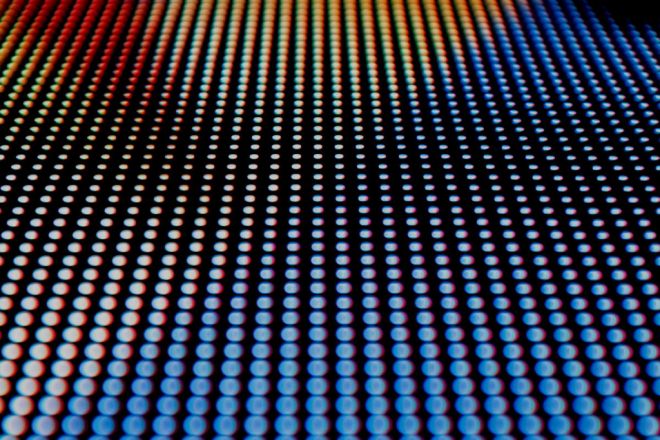Introduction

À mesure que les exigences des gens en matière d’expérience visuelle continuent de s’améliorer, l’effet d’affichage de Afficheurs LED est également confronté à des défis plus importants.
Parmi eux, la précision des couleurs est l'un des indicateurs importants pour mesurer l'effet d'affichage des écrans LED, et son importance est devenue de plus en plus importante. La précision des couleurs n'est pas seulement liée à la véritable restitution de l'image, mais affecte également directement l'expérience visuelle du public et la communication précise des informations.
Alors, quelle est la précision des couleurs de l'affichage LED ? Quel est le principe ? Vous le saurez après avoir lu cet article.
1. Concepts de base de la précision des couleurs des écrans LED

- La définition et la norme de mesure de la précision des couleurs
En termes simples, la précision des couleurs fait référence à la capacité de l'écran LED à restituer avec précision la couleur de l'image d'origine lors de l'affichage de l'image. Elle mesure la précision avec laquelle un écran affiche les couleurs dans la gamme de couleurs couverte. Pour les écrans LED, la précision des couleurs est l'un des indicateurs importants pour évaluer ses performances d'affichage.
Le principal paramètre permettant de mesurer la précision des couleurs est la valeur △E. Plus la valeur △E est petite, plus la précision des couleurs de l'écran est élevée, c'est-à-dire que plus la couleur affichée est proche de la couleur de l'image d'origine. Cependant, il convient de noter qu'en raison des limitations de la technologie d'affichage, aucun écran ne peut atteindre une norme de couleur absolue, de sorte que la valeur △E ne peut jamais être égale à 0. Dans les applications pratiques, nous recherchons la valeur △E la plus petite possible pour offrir des performances de couleur plus précises.
- Les principaux facteurs influençant la précision des couleurs de l'affichage LED
La précision des couleurs des écrans LED dépend de nombreux facteurs. Tout d'abord, le processus de fabrication et les matériaux de l'écran d'affichage ont un impact direct sur la précision des couleurs. Des puces LED de haute qualité, des circuits de commande précis et une technologie de contrôle d'affichage avancée contribuent tous à améliorer la précision des couleurs et les performances de l'écran.
Deuxièmement, les facteurs environnementaux auront également un impact sur la précision des couleurs. Par exemple, les conditions d'éclairage environnantes, l'angle d'affichage et la distance de visualisation peuvent avoir un certain impact sur la précision des couleurs de l'écran.
De plus, la qualité du contenu vidéo ou image lu est également un facteur important affectant la précision des couleurs. Si la couleur de l'image d'origine est inexacte, quelle que soit l'excellence de la précision des couleurs de l'écran, il ne sera pas en mesure de restituer la vraie couleur.
- La relation entre la précision des couleurs et l'expérience visuelle
Il existe un lien étroit entre la précision des couleurs et l'expérience visuelle. L'écran LED à haute précision des couleurs peut restituer plus précisément la couleur de l'image d'origine, rendant l'image plus réaliste et plus délicate. Cela contribue non seulement à améliorer le plaisir visuel du public, mais également à mieux transmettre les informations et à renforcer le sentiment d'immersion et d'implication du public.
Dans certains domaines d'application exigeant des couleurs élevées, comme l'imagerie médicale, la création artistique, etc., les écrans LED à haute précision de couleur jouent un rôle irremplaçable. Ils peuvent aider les médecins à diagnostiquer les maladies avec plus de précision et aider les artistes à mieux présenter leurs intentions créatives, améliorant ainsi les résultats des travaux dans les industries connexes.
Par conséquent, l’amélioration des performances de précision des couleurs des écrans LED est d’une grande importance pour améliorer l’expérience visuelle et promouvoir le développement des industries connexes.
2. Principes techniques de la précision des couleurs de l'affichage LED
En termes simples, la précision des couleurs d'un écran LED fait référence à la similitude de la couleur qu'il présente avec la couleur de l'image d'origine. Alors, comment garantir cette précision des couleurs ? Une série de technologies et de principes sont impliqués.
Tout d’abord, nous devons comprendre comment les puces LED émettent de la lumière. Imaginez que le courant est comme un jet d’eau. Lorsqu’il traverse la puce LED, il rencontre les électrons et les trous à l’intérieur de la puce. Lorsqu’ils se rencontrent et se tiennent par la main, ils libèrent de l’énergie, qui devient la lumière que nous voyons.
La couleur de la puce LED est différente en raison des différents types de matériaux et d'éléments dopants qu'elle contient, tout comme différents ingrédients créent des plats avec des saveurs différentes.
Alors, comment l'écran LED affiche-t-il des couleurs riches et colorées ? En fait, c'est comme un coloriste qui mélange les couleurs. Il existe trois types de puces LED dans l'écran : rouge, vert et bleu. En ajustant leur rapport de luminosité, tout comme un coloriste mélangeant différentes couleurs de peinture, nous pouvons obtenir la couleur que nous voulons.
Mais les puces LED ne suffisent pas à elles seules. Il faut aussi un « gros intendant » pour les gérer, à savoir le circuit de commande. Le circuit de commande est comme une alimentation électrique qui alimente les puces LED, garantissant qu'elles peuvent émettre de la lumière de manière stable.
Si le circuit d'entraînement n'est pas bien conçu, la puce LED peut présenter des problèmes tels qu'une luminosité inégale et une déviation des couleurs. Tout comme sur une scène avec un éclairage instable, la performance de l'acteur sera également affectée.
Pour afficher les couleurs avec plus de précision, nous devons utiliser une certaine « technologie noire ». Par exemple, contrôler avec précision le courant ou la tension pour que la puce LED émette de la lumière de manière plus stable.
Choisissez des composants électroniques de haute qualité pour réduire les interférences dans le circuit, tenez compte de l'impact des changements de température sur le circuit et effectuez une compensation de température, comme en été. C'est comme ajouter de l'eau dans la voiture pour la refroidir.
Outre l'optimisation au niveau du matériel, la technologie de contrôle de l'affichage joue également un rôle important. Elle agit comme un coloriste expérimenté, effectuant des réglages de couleur précis pour chaque pixel de l'écran afin d'éliminer les écarts de couleur causés par les processus de fabrication, les circuits d'entraînement et d'autres facteurs.
Enfin, n'oubliez pas le « directeur général » du système de gestion des couleurs. Il est responsable du traitement des données de couleur tout au long du processus d'affichage pour garantir la précision et la cohérence des couleurs.
Avec l'avancement continu de la technologie, les systèmes modernes de gestion des couleurs deviennent de plus en plus avancés, tout comme les réalisateurs de cinéma utilisent des moyens de haute technologie pour améliorer la qualité de l'image, rendant les couleurs que nous voyons plus réelles et plus vives.
3. Moyens techniques pour améliorer la précision des couleurs des écrans LED

- Méthodes et équipements d'étalonnage de haute précision
En termes simples, l'étalonnage de haute précision consiste à ajuster avec précision la couleur et la luminosité de l'écran LED pour garantir que l'image affichée est précise en termes de couleur et uniforme en termes de luminosité. Pour atteindre cet objectif, nous devons utiliser des méthodes et des équipements d'étalonnage professionnels.
Commençons par le contrôle de la lumière ambiante. Imaginez que vous regardez la télévision pendant la journée et que la lumière du soleil à l'extérieur de la fenêtre est très vive ; la couleur de l'image sur l'écran du téléviseur peut être affectée et ne pas apparaître aussi vive ou précise.
De même, les écrans LED sont également affectés par l'éclairage ambiant. Par conséquent, avant de procéder à l'étalonnage, nous devons nous assurer que l'intensité lumineuse autour de l'écran est modérée en ajustant les rideaux ou en utilisant un tissu occultant afin que les résultats de l'étalonnage soient plus précis.
Ensuite, il faut régler la luminosité. La luminosité de l'écran LED peut être réglée, mais comment peut-elle être réglée pour obtenir l'état le plus approprié ? Cela doit être effectué en fonction des caractéristiques du contenu de l'écran et des exigences de l'environnement d'affichage.
Par exemple, si des images aux tons sombres sont affichées, nous devons diminuer la luminosité de manière appropriée pour éviter que l'image ne paraisse trop éblouissante ; à l'inverse, si des images lumineuses et colorées sont affichées, nous devons augmenter la luminosité pour rendre l'image plus vive.
Outre la luminosité, la planéité de l'écran affecte également la qualité de l'image. Si la surface de l'écran est inégale, une répartition inégale de la luminosité peut se produire, ce qui entraîne des « points lumineux » ou des « zones sombres ». Par conséquent, nous devons également utiliser des instruments de correction des couleurs professionnels pour détecter et calibrer la planéité de l'écran afin de garantir que la luminosité de l'écran est uniformément répartie.
Alors, comment réaliser ces opérations d'étalonnage ? Cela nécessite l'utilisation d'un équipement professionnel. Par exemple, les instruments de mesure optique peuvent mesurer les performances optiques de l'écran d'affichage pour nous aider à comprendre la luminosité, la chromaticité et d'autres paramètres de l'écran d'affichage ;
Les instruments de mesure électroniques peuvent être utilisés pour tester les performances du circuit de l'écran d'affichage afin de garantir que le circuit est stable et fiable ; les instruments de mesure mécaniques peuvent être utilisés pour tester les propriétés mécaniques de l'écran d'affichage, telles que la planéité, etc. En comparant avec une source standard, ces appareils peuvent identifier avec précision les erreurs et les écarts de mesure et effectuer les ajustements d'étalonnage correspondants.
- Technologie d'extension de la gamme de couleurs et ses applications
La technologie d'extension de la gamme de couleurs semble très professionnelle et compliquée, mais en fait, son principe est très simple. On peut la considérer comme une sorte de « magie » qui permet à l'écran LED d'afficher des couleurs plus nombreuses et plus riches.
Comme nous le savons tous, les couleurs qu'un téléviseur ou un écran d'affichage ordinaire peuvent afficher sont limitées et, parfois, elles peuvent paraître un peu monotones ou irréalistes. La technologie d'extension de la gamme de couleurs est née pour résoudre ce problème.
Imaginez que vous avez une belle photo de paysage, mais que lorsque vous l'affichez sur un écran ordinaire, vous constaterez peut-être que certaines couleurs ne sont pas vives ou que certaines couleurs détaillées sont « rongées ». Et si vous utilisez un écran LED avec technologie d'extension de la gamme de couleurs, alors chaque couleur de cette photo sera plus réaliste et plus complète, comme si vous étiez sur place.
Comment fonctionne cette technologie ? En fait, elle utilise un algorithme et un logiciel spéciaux pour traiter l'image entrée sur l'écran d'affichage. Elle va convertir et étendre l'espace colorimétrique de l'image standard à petite gamme de couleurs d'origine afin que davantage de couleurs puissent être affichées. De cette façon, lorsque vous voyez l'image, les couleurs seront plus vives et plus riches, et les détails seront plus clairs.
Bien entendu, le logiciel seul ne suffit pas ; il faut également le support du matériel d'affichage. Ce n'est que lorsque l'écran peut représenter avec précision la gamme de couleurs étendue que nous pouvons voir des images plus réalistes et plus vives.
La technologie d'extension de la gamme de couleurs est donc comme une sorte de « magie des couleurs », qui rend les écrans LED plus « intelligents », capables de présenter des couleurs plus belles et de nous offrir une expérience visuelle plus choquante. Que vous regardiez la télévision à la maison, que vous jouiez à des jeux ou que vous exposiez dans des lieux commerciaux, vous pouvez ressentir le charme qu'elle apporte.
- Réglage et correction dynamiques des couleurs
La technologie de réglage et de correction dynamique des couleurs est en fait très pratique. Vous pouvez la considérer comme un « assistant de couleur » pour l'écran LED, l'aidant à ajuster la couleur à tout moment pour rendre l'image plus réelle et plus vivante.
Ce « petit assistant » est très intelligent. Il peut analyser les images affichées sur l'écran en temps réel pour voir la répartition des couleurs et les caractéristiques de ces images. Ensuite, il ajustera automatiquement les paramètres de couleur de l'écran en fonction de ces informations pour rendre les performances des couleurs plus précises et plus vives.
Ce « petit assistant » peut également détecter les changements de lumière ambiante. Par exemple, si la luminosité devient soudainement particulièrement élevée ou sombre, il ajustera immédiatement la luminosité et le contraste de l’écran pour garantir que l’image reste clairement visible. De cette façon, vous pouvez obtenir la meilleure expérience visuelle, que vous regardiez de jour comme de nuit.
De plus, il effectuera des corrections en temps réel en fonction des exigences du contenu affiché. Par exemple, si vous regardez un film avec beaucoup de couleurs vives, il ajustera automatiquement la saturation des couleurs et la teinte de l'écran pour rendre l'image plus vive et plus réaliste.
Par conséquent, la technologie de réglage et de correction dynamique des couleurs est comme un « personnalisateur personnel » des écrans LED, vous montrant les effets de couleur parfaits en fonction de différentes scènes et contenus. Que vous regardiez des films, jouiez à des jeux ou admiriez le magnifique paysage, vous pouvez profiter d'un festin visuel plus réaliste et plus vivant.
4. Application de la précision des couleurs des écrans LED dans différents domaines

La précision des couleurs des écrans LED est largement utilisée dans différents domaines. Les quatre domaines que vous avez mentionnés seront présentés en détail ci-dessous :
- Espaces de publicité et d'affichage commerciaux :
Les écrans LED attirent beaucoup d'attention dans les publicités commerciales grâce à leur luminosité élevée et à leurs couleurs vives. Les commerçants peuvent utiliser les écrans LED pour afficher des produits, des activités, des promotions et d'autres informations et transmettre des informations en peu de temps grâce à ses effets visuels uniques pour augmenter les effets publicitaires.
Les écrans LED permettent également une interaction en temps réel et une personnalisation personnalisée. Les commerçants peuvent ajuster le contenu de l'affichage en fonction des caractéristiques des différentes périodes et des différents groupes de personnes pour obtenir une publicité plus ciblée.
De plus, grâce à des fonctions interactives, les consommateurs peuvent participer au vote, laisser des messages et participer à d’autres activités pour renforcer leur sentiment de participation.
Les fonctionnalités promotionnelles multiplateformes des écrans LED les rendent également populaires dans le domaine commercial. Ils peuvent non seulement être installés dans des magasins physiques, mais également intégrés dans des véhicules publicitaires mobiles, des grands écrans dans des centres commerciaux et d'autres endroits pour élargir le champ de la promotion.
- Domaines de production et de diffusion cinématographiques et télévisuelles :
Dans la production cinématographique et télévisuelle, les écrans LED peuvent être utilisés comme écrans d'arrière-plan pour présenter des images et des vidéos haute définition, offrant des effets visuels réalistes pour les films, les séries télévisées, etc.
Dans les salles de cinéma ou les home cinéma, la qualité d'image haute définition et la précision des couleurs des écrans LED peuvent garantir aux spectateurs la meilleure expérience visuelle.
- Lieux de représentation scénique et d'arts du spectacle :
Les écrans LED jouent un rôle important dans les performances scéniques. Ils peuvent être utilisés comme écran d'arrière-plan pour afficher des images et des vidéos liées au contenu de la performance, améliorant ainsi l'expression artistique de la scène et l'expérience visuelle du public.
Lors de concerts, de spectacles de danse et d'autres occasions, les écrans LED peuvent également être utilisés pour afficher les paroles, les mouvements des danseurs et d'autres informations en temps réel, offrant au public un contenu de visualisation plus riche.
- Expositions d'art et musées :
Les écrans LED jouent un rôle important dans la présentation des œuvres d'art. Le musée utilise des écrans LED pour afficher des images haute définition de reliques culturelles et d'œuvres d'art, permettant aux visiteurs d'apprécier de près de précieuses reliques culturelles.
Les écrans LED peuvent également être utilisés pour présenter le contexte historique, le processus de production et d'autres informations connexes sur les reliques culturelles afin d'améliorer l'expérience visuelle du public.
Les écrans LED jouent également un rôle important dans la surveillance de la sécurité des musées. Grâce au système de contrôle à grand écran LED, l'écran de surveillance de sécurité peut être présenté sur une interface d'affichage d'informations complète pour permettre le partage d'informations et une commande et une répartition unifiées.
Conclusion
En résumé, la précision des couleurs des écrans d’affichage LED, en tant qu’indicateur clé pour mesurer son effet d’affichage, joue un rôle décisif dans la communication visuelle moderne.
Grâce à des recherches approfondies et à une innovation continue, nous continuons d'améliorer les performances de précision des couleurs des écrans LED, rendant les images plus réalistes et délicates et offrant une expérience visuelle plus choquante au public.
Enfin, si vous souhaitez en savoir plus sur les écrans LED, veuillez nous contacter.
